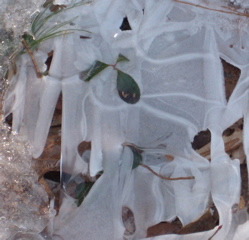I don’t care what Punxsutawney Phil saw–shadow, schmadow–spring is coming soon. This morning my son pulled on my daughter’s sleeve, sending her into a rage. Her hair is matted like would-be, white-girl-dreadlocks from lack of combing after swimming at the Y yesterday, and she won’t let me brush it–she prefers to glare at me instead, while snot drips from her nose. Is this not the death of winter and the labor pains of spring? I think it is. Please, God, let it be so.
 Spring is the season of surprises–when pale green shoots break through the frozen earth, or poke up between broken pieces of asphalt, to claim their places in the sun. Such brazen, bold, and unlikely beginnings give way to the overwhelmingly lush greenery, unpredictable winds and growing warmth of the season. Just as my daughter’s anger gives way easily and naturally. She sat down at the table in her hateful huff, and began to draw and cut. 10 minutes later she had her just-made paper-crown atop her head. “Now,” she proclaimed in her best voice o’ royalty, “I’m Queen of the house!”
Spring is the season of surprises–when pale green shoots break through the frozen earth, or poke up between broken pieces of asphalt, to claim their places in the sun. Such brazen, bold, and unlikely beginnings give way to the overwhelmingly lush greenery, unpredictable winds and growing warmth of the season. Just as my daughter’s anger gives way easily and naturally. She sat down at the table in her hateful huff, and began to draw and cut. 10 minutes later she had her just-made paper-crown atop her head. “Now,” she proclaimed in her best voice o’ royalty, “I’m Queen of the house!”
Anger is a much maligned emotion. But take away all the bad things people do in anger–petty acts of revenge, screaming matches, murder–and anger’s quick moving-power can be a refreshing burst of energy. What I’ve done with anger has, at times been as stunning as what the little green plants, those first to poke their heads out of winter’s wasteland, have done. Like the time I was running on a bike path and a man lurked in the bushes up ahead. No one else was on the path. I was angry, and instinctively showed him some attitude. I started growling, loud and low, and I made my stride strong and fluid. He took off through the woods away from the path.
Wang Pi (226-249, greatest commentator on the Lao-tzu) is reported to have said
…what the sage has in common with ordinary people are the emotions. The sage has a superior spirit, and therefore is able to be in harmony with the universe and to hold communion with Wu [i.e., the Tao]. But the sage has ordinary emotions, and therefore cannot respond to things without joy or sorrow. He responds to things, yet is not ensnared by them.” (Commentary, Chapter 28).
[From A Short History of Chinese Philosophy by Fung Yu-Lan.].
While it is easy to be ensnared by anger, it is also easy to learn useful information from it. Disentangled from anger, look at it’s value as information-laden energy: Anger tells us
- About ourselves: what we like and don’t like, what we are comfortable with and not-comfortable with, how important something is to us, etc.
- About our world and our people: can we trust this situation or individual, do we feel valued and respected in this situation or by these people?
- About how well our boundaries (or lack of them) serves us: Is there something I can do to respect and value myself which will alter my relationship to situations or people with whom I am angry?
My daughter’s simple rage told her: She is uncomfortable with sensory stimulation (sleeve-pulling, hair-brushing) that she is not ready for, that younger brothers and mothers with agendas (I didn’t just say, brush your hair! I started brushing it for her without so much as a “may I…”) don’t always respect her need to prepare for sensory stimulation. And finally, her art project was just the thing she needed to do to affirm her “queen-ness” in her own home (read, body).
Healthy anger is like wind. When it comes, it helps us to readjust our course, re-establish communication where it has broken down (such as when your mom attacks your rats’ nest hair with a brush instead of asking), and then it is gone, like the wind. For me, the winds of anger that swept through the house this morning were a reminder of that delicious spring forcefulness so useful for new beginnings. That same forcefulness is pulsing right now beneath the piles of melting snow outside. It’s that energy that I am counting on as it rises to give me the violent, surging energy of a new green shoot pushing up to the sun, as I continue working on my yearly Abundance (read, business) plan.
P.S. I’ve already had one burst of spring-like exuberance in my thinking, which luckily for me has trickled like the melting snow into small rivers of creativity in my mind. In that sudden burst of creative thinking I jumped out of the deep solo contemplation of my project, (in other words) my isolation (appropriate for winter, not for spring), and I have made two important contacts with people who should be helpful to me as I move forward on the cake project. More on that in my next Sagely Living Post!




